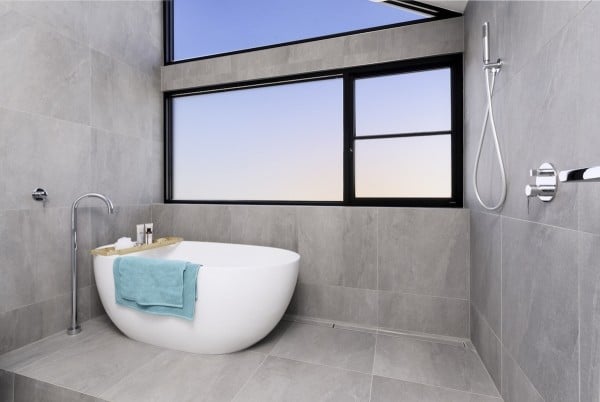Top tips to make your bathroom feel bigger
While we must all live within spaces defined by walls, there are ways to ‘stretch’ room boundaries through clever property design.
It’s become even more important as we try and fit more population into less area at an affordable price.
It means smaller blocks of land which limit the size of homes.
The goal of smart building design is to come up with solutions so clients can have what they want within the space provided.
In this sense, there are few areas in a house where the balance of space and function are more challenging than in the bathroom.
Here are our top tips on how to maximise the limited space many bathrooms offer?
Maximise vertical space in your bathroom
High ceilings create a sense of grandeur in living rooms, but they aren’t without their benefits in a bathroom either.
If you have high ceilings, look at ways to go up, rather than push out.
High cupboards and shelves are handy – particularly for storing items that aren’t needed daily, such as backup supplies of toiletries. Cupboard doors can hide these away and help protect them from moisture too.
Here’s a tip – if ‘going up’ for storage is on your agenda, ensure your bathroom has an adequate exhaust fan or great natural ventilation to avoid damp space.
Also, if you have a built-in linen cupboard in your bathroom, don’t stop the shelves at door height. See if there’s a chance to give high clearance inside the cupboard itself.
Shower smarts
In many cases, the bathtub has become an indulgence most owners don’t need.
If you really want a tub, but have limited room, then the shower-over-bath option has been a great space saver for decades.
If you’re forgoing the bath, however, think about the shower placement.
Showers are essentially a space enclosed by three walls and an entry way. Rather than installing a stand-alone recess, incorporate it into the room design. This works particularly well in long, skinny bathrooms and ensuites.
By thinking about the placement of a drain and full height wall tiling, you can create a shower simply by installing a glass screen that ‘locks off’ one end of the room.
Hanging Storage
Towel racks are essential, but some designs can be bulky and impede into the limited area.
Think carefully about rack placement and how double racks might help increase the hanging space without being too bulky.
Also – towel hooks can be a great solution. Hooks take up substantially less wall area and can provide for multiple users’ towels. They are also a great option for hanging clothes while you bath, so they don’t end up wet on the floor.
Hooks can also be placed in tight area such as on the backs of door or in a narrow gap between a vanity and a shower.
They’re an excellent way to hang your hand towel when space is tight too.
Bathroom vanity storage
Vanity and basin design has come a long way in recent years. Not only are they the height of style and distinction in a bathroom, they can provide excellent space-saving solutions.
Be smart in your choice of vanity. If you don’t have room for a large bench, consider a cube-style basin with flat area either side of the sink. Many have a spot for the hand soap pump or a place to sit your electric toothbrush.
Look for under-basin cupboards regardless of the vanity’s size. These are always useful for storage. I’ve even seen designs where the dirty clothes basket was incorporated into the vanity cupboard which helped free up space and kept the area clean.
Some vanities are designed for corner placement too – perfect in tight bathroom zones.
Recessed shelves to create space
Internal walls sheets are separated by a cavity that both insulates and carries utilities such as water pipes and electric cables.
Fortunately, wall cavities provide a chance to save space as well.
Instead of a shower shelf protruding into the shower area, think about recessing into the wall cavity. It looks stylish and is a great solution for somewhere to store the shampoo, conditioner, and soap.
Another move is to recess mirror cabinets into the wall cavity. This eye-height storage is a must in modern bathrooms. You’ll gain valuable storage depth for the items you use most, and you can even have power points inside the cupboard for recharging things like shavers and trimmers.
Another clever use for wall cavities in tight spaces is with the door design. If limited space makes a swinging entry door impractical, look at installing a cavity-slider. They are lockable and have a ‘clean’ look.
Some see limited space as a problem, but it can be an opportunity. Don’t just shrug your shoulders and write off tight bathrooms as an unfortunate compromise. Instead, get together with your builder and look at savvy solutions that will create a feeling of spaciousness.






